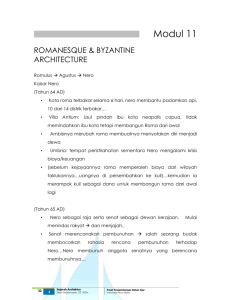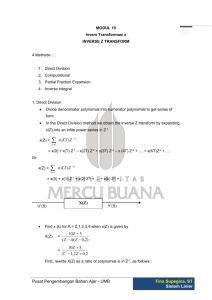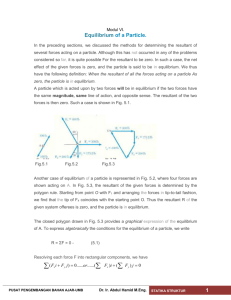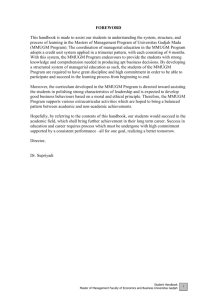Modul 12
advertisement
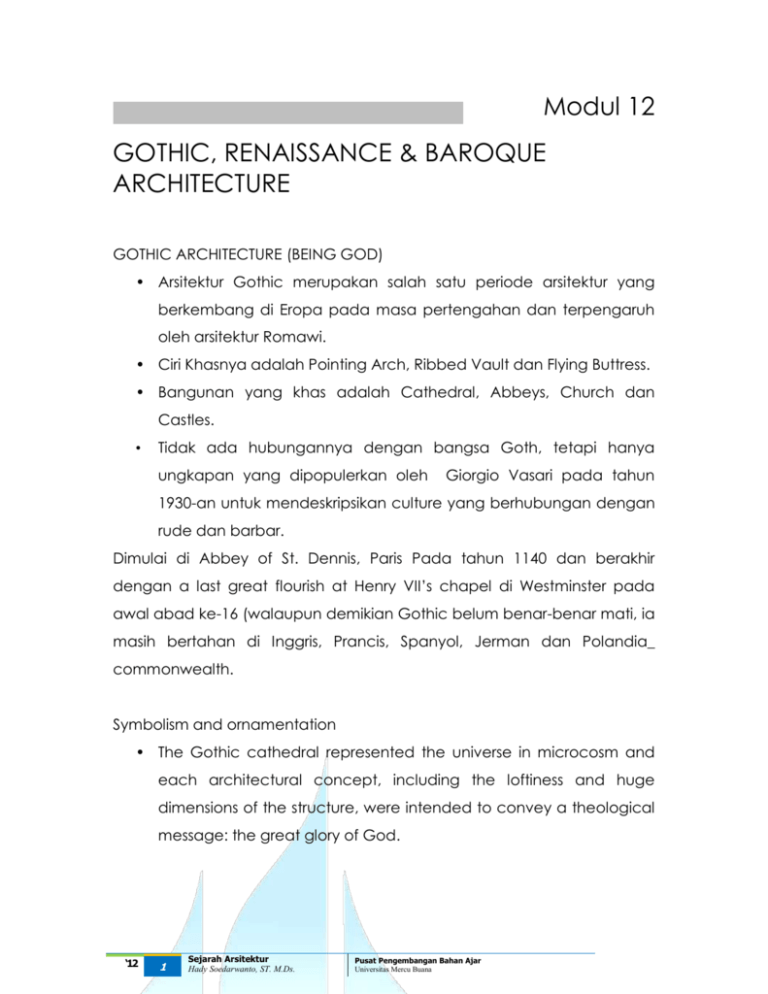
Modul 12 GOTHIC, RENAISSANCE & BAROQUE ARCHITECTURE GOTHIC ARCHITECTURE (BEING GOD) • Arsitektur Gothic merupakan salah satu periode arsitektur yang berkembang di Eropa pada masa pertengahan dan terpengaruh oleh arsitektur Romawi. • Ciri Khasnya adalah Pointing Arch, Ribbed Vault dan Flying Buttress. • Bangunan yang khas adalah Cathedral, Abbeys, Church dan Castles. • Tidak ada hubungannya dengan bangsa Goth, tetapi hanya ungkapan yang dipopulerkan oleh Giorgio Vasari pada tahun 1930-an untuk mendeskripsikan culture yang berhubungan dengan rude dan barbar. Dimulai di Abbey of St. Dennis, Paris Pada tahun 1140 dan berakhir dengan a last great flourish at Henry VII’s chapel di Westminster pada awal abad ke-16 (walaupun demikian Gothic belum benar-benar mati, ia masih bertahan di Inggris, Prancis, Spanyol, Jerman dan Polandia_ commonwealth. Symbolism and ornamentation • The Gothic cathedral represented the universe in microcosm and each architectural concept, including the loftiness and huge dimensions of the structure, were intended to convey a theological message: the great glory of God. ‘12 1 Sejarah Arsitektur Hady Soedarwanto, ST. M.Ds. Pusat Pengembangan Bahan Ajar Universitas Mercu Buana • The building becomes a microcosm in two ways. Firstly, the mathematical and geometrical nature of the construction is an image of the orderly universe, in which an underlying rationality and logic can be perceived. Secondly, the statues, sculptural decoration, stained glass and murals • Many churches were very richly decorated, both inside and out. Sculpture and architectural details were often bright with coloured paint of which traces remain at Chartres cathedral. Wooden ceilings and panelling were usually brightly coloured. Sometimes the stone columns of the nave were painted, and the panels in decorative wall arcading contained narratives or figures of saints. These have rarely remained intact, but may be seen at the Chapterhouse of Westminster Abbey. • A further regional influence was the availability of materials. In France, limestone was readily available in several grades, the very fine white limestone of Caen being favoured for sculptural decoration. England had coarse limestone, red sandstone as well as dark green Purbeck marble which was often used for architectural features. • In Northern Germany, Netherlands, Scandinavia, Baltic countries and northern Poland local building stone was unavailable but there was a strong tradition of building in brick. The resultant style, Brick Gothic, is called "Backsteingotik“ • In Italy, stone was used for fortifications, but brick was preferred for other buildings. Because of the extensive and varied deposits of marble, many buildings were faced in marble. • The availability of timber also influenced the style of architecture. ‘12 2 Sejarah Arsitektur Hady Soedarwanto, ST. M.Ds. Pusat Pengembangan Bahan Ajar Universitas Mercu Buana • The pointed arch had its origins in ancient Assyrian architecture where it occurs in a number of structures as early as 720 BC. It passed into Sassanian-Persian architecture and from the conquest of Persia in 641 AD, became a standard feature of Islamic architecture. • The Norman conquest of Islamic Sicily in 1090, the Crusades which began in 1096 and the Islamic presence in Spain all brought about a knowledge of this significant structural device. It is probable also that decorative carved stone screens and window openings filled with pierced stone also influenced Gothic tracery. In Spain in particular individual decorative motifs occur which are common to both Islamic and Christian architectural mouldings and sculpture. • Concurrent with its introduction and early use as a stylistic feature in French churches, it is believed that the pointed arch evolved naturally in Western Europe as a structural solution to a purely technical problem. • In Gothic architecture, new technology stands behind the new building style. That new technology was the ogival or pointed arch. Other characteristics developed as the consequence of the use of the pointed arch. • The Gothic style, when applied to an ecclesiastical building, emphasizes verticality and light. This appearance was achieved by the development of certain architectural features, which together provided an engineerical solution. The structural parts of the building ceased to be its solid walls, and became a stone skeleton comprised of clustered columns, pointed ribbed vaults and flying buttresses ‘12 3 Sejarah Arsitektur Hady Soedarwanto, ST. M.Ds. Pusat Pengembangan Bahan Ajar Universitas Mercu Buana • In some churches with double aisles, like Notre Dame, Paris, the transept does not project beyond the aisles. In English cathedrals transepts tend to project boldly and there may be two of them, as at Salisbury Cathedral, though this is not the case with lesser churches. • In some churches with double aisles, like Notre Dame, Paris, the transept does not project beyond the aisles. In English cathedrals transepts tend to project boldly and there may be two of them, as at Salisbury Cathedral, though this is not the case with lesser churches. ‘12 4 Sejarah Arsitektur Hady Soedarwanto, ST. M.Ds. Pusat Pengembangan Bahan Ajar Universitas Mercu Buana Height • A characteristic of Gothic church architecture is its height, both real and proportional. A section of the main body of a Gothic church usually shows the nave as considerably taller than it is wide. • In England the proportion is sometimes greater than 2:1, while the extreme is reached at Cologne Cathedral with a ratio of 3.6:1. • The extreme of actual internal height was achieved at Beauvais Cathedral at 157' 6" (48 meters). • Externally, towers and spires are characteristic of Gothic churches both great and small, the number and positioning being one of the greatest variables in Gothic architecture. • Smaller churches usually have just one tower, but this may also be the case at a very large cathedral like Salisbury or Ulm Cathedral, which has the tallest spire in the world at 527 feet (160 metres). ‘12 5 Sejarah Arsitektur Hady Soedarwanto, ST. M.Ds. Pusat Pengembangan Bahan Ajar Universitas Mercu Buana LIGHT One of the most distinctive characteristics of Gothic architecture is the expansive area of the windows • The facade of a large church or cathedral, often referred to as the West Front, is generally designed to create a powerful impression on the approaching worshipper, demonstrating both the might of God, and the might of the institution that it represents. One of the best known and most typical of such facades is that of Notre Dame de Paris. Equilateral arch • Many Gothic openings are based upon the equilateral form. The Equilateral Arch gives a wide opening of satisfying proportion useful for doorways, decorative arcades and big windows. ‘12 6 Sejarah Arsitektur Hady Soedarwanto, ST. M.Ds. Pusat Pengembangan Bahan Ajar Universitas Mercu Buana • The structural beauty of the Gothic arch means, however, that no set proportion had to be rigidly maintained. • The Equilateral Arch lends itself to filling with tracery of simple equilateral, circular and semi-circular forms. The Flamboyant • The Flamboyant Arch is one that is draughted from four points, the upper part of each main arc turning upwards into a smaller arc and meeting at a sharp, flame-like point. RENAISSANCE ARCHITECTURE (ENLIGHTMENT) Humanism was the most significant intellectual movement of the Renaissance. It blended concern for the history and actions of human beings with religious concerns. The humanists were scholars and artists who studied subjects that they believed would help them better understand the problems of humanity. These subjects included literature and philosophy. The humanists shared the view that the civilizations of ancient Greece and Rome had excelled in such subjects and thus could serve as models. They believed that people should understand and appreciate classical antiquity to learn how to conduct their lives. Quote by Professor Nikolaus Pevsner, ‘the Gothic style was created for Suger, Abbot of St. Denis, counselor of the kings of France, the Renaissance for the merchants of Florence, bankers to the kings of Europe.’ Gothic and Renaissance architecture, great as they are were not created overnight. They have periods of gestation and are the product of functional necessity and of historical forces. It is true that Gothic architecture was primarily ecclesiastical (places of worship) in nature and that Renaissance was primarily royal and mercantile (even for the places ‘12 7 Sejarah Arsitektur Hady Soedarwanto, ST. M.Ds. Pusat Pengembangan Bahan Ajar Universitas Mercu Buana of worship). The development of architecture was influenced by the political development of the country and region. During the Middle Ages, the most important branch of learning was theology (the study of God). However, many Renaissance thinkers paid greater attention to the study of humanity. They examined the great accomplishments of different cultures, particularly those of ancient Greece and Rome. Medieval artists painted human figures that looked stiff and unrealistic and which often served symbolic, religious purposes. But Renaissance artists stressed the beauty of the human body. They tried to capture the dignity and majesty of human beings in lifelike paintings and sculptures. For centuries, most scholars have agreed that the modern era of human history began with the Renaissance. For example, Leonardo da Vinci who painted two of the most famous works of Renaissance art, the wallpainting The Last Supper (about 1497) and the portrait Mona Lisa (about 1503) was such a person. Leonardo had one of the most searching minds in all history. He wanted to know the workings of everything he saw in nature. In more than 4,000 pages of notebooks, he drew detailed diagrams and wrote down observations. Leonardo made careful drawings of human skeletons and muscles, trying to discover how the body worked. Because of his inquiring mind, Leonardo has become a symbol of the Renaissance spirit of learning and intellectual curiosity. Renaissance architecture is the architecture of the period between the early 15th and early 17th centuries in different regions of Europe, in which there was a conscious revival and development of certain elements of Classical Greek and Roman thought and material culture. ‘12 8 Sejarah Arsitektur Hady Soedarwanto, ST. M.Ds. Pusat Pengembangan Bahan Ajar Universitas Mercu Buana The Renaissance style places emphasis on symmetry, proportion, geometry and the regularity of parts as they are demonstrated in the architecture of Classical antiquity and in particular, the architecture of Ancient Rome. Orderly arrangements of columns, pilasters and lintels, as well as the use of semicircular arches, hemispherical domes, niches and aedicules replaced the more complex proportional systems and irregular profiles of medieval buildings. Developed first in Florence, with Filippo Brunelleschi as one of its innovators, the Renaissance style quickly spread to other Italian cities and then to France, Germany, England, Russia and elsewhere. Quattrocento • In the Quattrocento, concepts of architectural order were explored and rules were formulated. The study of classical antiquity led in particular to the adoption of Classical detail and ornamentation. • Space was organised by proportional logic, its form and rhythm subject to geometry, rather than being created by intuition as in Medieval buildings. The prime example of this is the Basilica di San Lorenzo in Florence by Filippo Brunelleschi (1377–1446). ‘12 9 Sejarah Arsitektur Hady Soedarwanto, ST. M.Ds. Pusat Pengembangan Bahan Ajar Universitas Mercu Buana High Renaissance • During the High Renaissance, concepts derived from classical antiquity were developed and used with greater surety. The most representative architect is Bramante (1444–1514) who expanded the applicability of classical architecture to contemporary buildings. His San Pietro in Montorio (1503) was directly inspired by circular Roman temples. He was, however, hardly a slave to the classical forms and it was his style that was to dominate Italian architecture in the 16th century Mannerism ‘12 10 Sejarah Arsitektur Hady Soedarwanto, ST. M.Ds. Pusat Pengembangan Bahan Ajar Universitas Mercu Buana During the Mannerist period, architects experimented with using architectural forms to emphasize solid and spatial relationships. The Renaissance ideal of harmony gave way to freer and more imaginative rhythms. The best known architect associated with the Mannerist style was Michelangelo (1475–1564), who is credited with inventing the giant order, a large pilaster that stretches from the bottom to the top of a facade. He used this in his design for the Campidoglio in Rome. • Giulio Romano • Baldassare Peruzzi • Giacomo della Porta • Andrea palladio Characteristics of Renaissance architecture The obvious distinguishing features of Classical Roman architecture were adopted by Renaissance architects. However, the forms and purposes of buildings had changed over time. So had the structure of cities. Among the earliest buildings of the reborn Classicism were churches of a type that the Romans had never constructed. Neither were there models for the type of large city dwellings required by wealthy merchants of the 15th century. Conversely, there was no call for enormous sporting fixtures and public bath houses such as the Romans had built. The ancient orders were a n a l y s e d and r e c o n s t r u c t e d t o s e r v e es PLANS ‘12 11 Sejarah Arsitektur Hady Soedarwanto, ST. M.Ds. Pusat Pengembangan Bahan Ajar Universitas Mercu Buana new purpos The plans of Renaissance buildings have a square, symmetrical appearance in which proportions are usually based on a module. Within a church the module is often the width of an aisle. The need to integrate the design of the plan with the façade was introduced as an issue in the work of Filippo Brunelleschi, but he was never able to carry this aspect of his work into fruition. The first building to demonstrate this was St. Andrea in Mantua by Alberti. The development of the plan in secular architecture was to take place in the 16th century and culminated with the work of Palladio FASCADE Façades are symmetrical around their vertical axis. Church facades are generally surmounted by a pediment and organized by a system of pilasters, arches and entablatures. The columns and windows show a progression towards the center. Domestic buildings are often surmounted by a cornice. There is a regular repetition of openings on each floor, and the centrally placed door is marked by a feature such as a balcony, or rusticated surround. An early and much copied prototype was the façade for the Palazzo Rucellai (1446 and 1451) in Florence with its three registers of pilasters COLUMN AND PILASTER The Roman orders of columns are used:- Tuscan, Doric, Ionic, Corinthian and Composite. The orders can either be structural, supporting an arcade or architrave, o r purely decorative, set against a wall in the form of pilasters. During the Renaissance, architects aimed to use columns, pilasters, and entablatures as an integrated system. One of the first ‘12 12 Sejarah Arsitektur Hady Soedarwanto, ST. M.Ds. Pusat Pengembangan Bahan Ajar Universitas Mercu Buana buildings to use pilasters as an integrated system was in the Old Sacristy (1421–1440) by Brunelleschi. ARCHES Arches are semi-circular or (in the Mannerist style) segmental. Arches are often used in arcades, supported on piers or columns with capitals. There may be a section of entablature between the capital and the springing of the arch. Alberti was one of the first to use the arch on a monumental scale at the St. Andrea in Mantua. VAULTS Vaults do not have ribs, they are semi-circular or segmental and on a square plan. (unlike the Gothic vault which is frequently rectangular). The barrel vault, is returned to architectural vocabulary as at the St. Andrea in Mantua. ‘12 13 Sejarah Arsitektur Hady Soedarwanto, ST. M.Ds. Pusat Pengembangan Bahan Ajar Universitas Mercu Buana DOMES The Dome of St Peter's Basilica, Rome. The dome is used frequently, both as a very large structural feature that is visible from the exterior, and also as a means of roofing smaller spaces where they are only visible internally. Brunelleschi’s design for the Basilica di Santa Maria del Fiore and its use in Bramante’s plan for St. Peter's Basilica in Rome. DOORS Door usually have square lintels. They may be set within an arch or surmounted by a triangular or segmental pediment. Openings that do not have doors are usually arched and frequently have a large or decorative keystone. CEILINGS Roofs are fitted with flat or cofferedceilings. They are not left open as in Medieval architecture. They are frequently p a i n t e d or d e c o r a t ed. ‘12 14 Sejarah Arsitektur Hady Soedarwanto, ST. M.Ds. Pusat Pengembangan Bahan Ajar Universitas Mercu Buana WINDOWS Windows may be paired and set within a semi-circular arch. They may have square lintels and triangular or segmental pediments, which are often used alternately. Emblematic in this respect is the Palazzo Farnese in Rome, begun in 1517. WALLS External walls are generally of highly-finished ashlar masonry, laid in straight courses. The corners of buildings are often emphasised by rusticated “quoins”. Basements and ground floors were often rusticated, as modeled on the Palazzo Medici Riccardi (1444–1460) in Florence. Internal walls are smoothly plastered and surfaced with white-chalk paint. For more formal spaces, internal surfaces are decorated with frescoes. DETAILS Courses, moldings and all decorative details are carved with great precision. Moldings stand out around doors and windows rather than being recessed, as in Gothic Architecture. ‘12 15 Sejarah Arsitektur Hady Soedarwanto, ST. M.Ds. Pusat Pengembangan Bahan Ajar Universitas Mercu Buana Influences on the development of Renaissance architecture in Italy (Architectural). Italy had never fully adopted the Gothic style of architecture. Apart from the Cathedral of Milan, largely the work of German builders, few Italian churches show the emphasis on vertically, the clustered shafts, ornate tracery and complex ribbed vaulting that characterise Gothic in other parts of Europe. Italian architects had always preferred forms that were clearly defined and structural members that expressed their purpose. The presence, particularly in Rome, of architectural remains showing the ordered Classical style provided an inspiration to artists at a time when philosophy was also turning towards the Classical. De re aedificatoria (English: On the Art of Building) by Leon Battista - 1450. 'De architectura, Vitruvius – 1414. De re aedificatoria in 1485 became the first printed book on architecture. Regole generali d'architettura” (General Rules of Architecture), Sebastiano Serlio (1475 – c. 1554) “Quattro Libri dell'Architettura”, (The Four Books of Architecture) Andrea Palladio (1508 –1580) BAROQUE ARHITECTURE • In similar profusions of detail, art, music, architecture, and literature inspired each other in the Baroque cultural movement (citation needed) as artists explored what they could create from repeated and varied patterns. Some traits and aspects of Baroque paintings that differentiate this style from others are the abundant amount of details, often bright polychromy, less realistic faces of subjects, and an overall sense of awe, which was one of the goals in Baroque art. ‘12 16 Sejarah Arsitektur Hady Soedarwanto, ST. M.Ds. Pusat Pengembangan Bahan Ajar Universitas Mercu Buana • The word baroque probably derives from the ancient Portuguese noun "barroco“ [citation needed] which is a pearl that is not round but of unpredictable and elaborate shape. • Hence, in informal usage, the word baroque can simply mean that something is "elaborate", with many details, without reference to the Baroque styles of the seventeenth and eighteenth centuries. Baroque architecture, starting in the early 17th century in Italy, took the humanist Roman vocabulary of Renaissance architecture and used it in a new rhetorical, theatrical, sculptural fashion, expressing the triumph of absolutist church and state. New architectural concerns for color, light and shade, sculptural values and intensity characterize the Baroque. It is characterized by exuberant decoration, expansive curvaceous forms, a sense of mass, a delight in large-scale and sweeping vistas, and a preference for spatially complex compositions. The term applies fully to the 17th century in Italy and to the 17th and 18th Century in Spain, Germany and Austria but with limitations to the 17th century in France (Le Vau for Versailles), the 18th century in Italy (Fontana, Juvarra), and the late 17th century and early 18th century in England (Wren, Hawksmoor, Vanbrugh, Archer) ‘12 17 Sejarah Arsitektur Hady Soedarwanto, ST. M.Ds. Pusat Pengembangan Bahan Ajar Universitas Mercu Buana Baroque architecture is a relatively simple and unified idea expressed as directly as possible and with the utmost force. Columns, semi-columns, pilasters, pediments and sculpture rise to a single climax. The Scala Regia (1663-6) is a tremendous stairway between the St Peter’s Piazza and the papal apartments. It forms the main entrance to the Vatican Palace, but had to be fitted in a narrow awkward site between a porch and the palace. Using a false perspective, it was created by the tapering of the plan, where you feel that the sense is still processional. Based on two equilateral triangles with arcs and segments drawn from various points of their intersection, it resolves itself at the level of the dome into an oval and at the lantern into a circle. The whole of the architecture becomes plastic almost molten. Borromini treated architecture as abstract sculpture. ‘12 18 Sejarah Arsitektur Hady Soedarwanto, ST. M.Ds. Pusat Pengembangan Bahan Ajar Universitas Mercu Buana • The blending of religious and erotic; it is part of the genius of the Baroque. • In Baroque architecture, new emphasis was placed on bold massing, colonnades, domes, light-and-shade (chiaroscuro), 'painterly' color effects, and the bold play of volume and void. • In interiors, Baroque movement around and through a void informed monumental staircases. Important features of baroque architecture include: • Long, narrow naves are replaced by broader, occasionally circular forms. • Dramatic use of light, either strong light-and-shade contrasts, chiaroscuro effects or uniform lighting by means of several windows. • Opulent use of ornaments. • Large-scale ceiling frescoes • The external facade is often characterized by a dramatic central projection • the interior is often no more than a shell for painting and sculpture (especially in the late baroque) • Illusory effects, the blending of painting and architecture • in the Bavarian, Czech, Polish, and Ukrainian baroque, pear domes are ubBaroque actually expressed new values, which often are summarized in the use of metaphor and allegory, widely found in Baroque literature, and in the research for the "maraviglia" (wonder, astonishment — as in Marinism), the use of artifices. • • Virtuosity was researched by artists (and the virtuoso became a common figure in any art) together with realism and care for details ‘12 19 Sejarah Arsitektur Hady Soedarwanto, ST. M.Ds. Pusat Pengembangan Bahan Ajar Universitas Mercu Buana ROCOCO • A style of 18th century French art and interior design, Rococo style rooms were designed as total works of art with elegant and ornate furniture, small sculptures, ornamental mirrors, and tapestry complementing architecture, reliefs, and wall paintings. It was largely supplanted by the Neoclassic style. • The word Rococo is seen as a combination of the French rocaille, or shell, and the Italian barocco (Baroque) style. • Due to Rococo love of shell-like curves and focus on decorative arts, some critics used the term to derogatively imply that the style was frivolous or merely fashion. • interestingly, when the term was first used in English in about 1836, it was a colloquialism meaning "old-fashioned". Rococo is now widely recognized as a major period in the development of European art ‘12 20 Sejarah Arsitektur Hady Soedarwanto, ST. M.Ds. Pusat Pengembangan Bahan Ajar Universitas Mercu Buana
